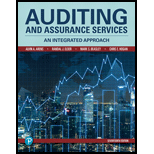
Auditing And Assurance Services
17th Edition
ISBN: 9780134897431
Author: ARENS, Alvin A.
Publisher: PEARSON
expand_more
expand_more
format_list_bulleted
Question
Chapter 11, Problem 1RQ
To determine
Identify the three broad objectives for internal control that an auditor uses during the audit of financial statement and internal control over financial reporting.
Expert Solution & Answer
Explanation of Solution
An auditor uses three broad categories to ensure effective internal controls during the audit of financial statement and internal control over financial reporting, they are given as follows:
- To ensure reliability of reporting of financial and non-financial statements.
- To ensure effectiveness and efficiency in optimizing the use of firm’s scarce resources.
- To ensure firm’s comply with the rules and regulations states in Section 404 while issuing a report.
Want to see more full solutions like this?
Subscribe now to access step-by-step solutions to millions of textbook problems written by subject matter experts!
Students have asked these similar questions
Please provide the answer to this financial accounting question with proper steps.
What is the cash balance at October 31,2022
Please provide the solution to this financial accounting question using proper accounting principles.
Chapter 11 Solutions
Auditing And Assurance Services
Ch. 11 - Prob. 1RQCh. 11 - Prob. 2RQCh. 11 - Prob. 3RQCh. 11 - Prob. 4RQCh. 11 - Prob. 5RQCh. 11 - Prob. 6RQCh. 11 - Prob. 7RQCh. 11 - Prob. 8RQCh. 11 - Prob. 9RQCh. 11 - Prob. 10RQ
Ch. 11 - Prob. 11RQCh. 11 - Prob. 12RQCh. 11 - Prob. 13RQCh. 11 - Prob. 14RQCh. 11 - Prob. 15RQCh. 11 - Prob. 16RQCh. 11 - Prob. 17RQCh. 11 - Prob. 18RQCh. 11 - Prob. 19RQCh. 11 - Prob. 20.1MCQCh. 11 - Actions, policies, and procedures that reflect the...Ch. 11 - Prob. 20.3MCQCh. 11 - Prob. 21.1MCQCh. 11 - Prob. 21.2MCQCh. 11 - Prob. 21.3MCQCh. 11 - Prob. 22.1MCQCh. 11 - Prob. 22.2MCQCh. 11 - Which of the following correctly describes an...Ch. 11 - Prob. 23DQPCh. 11 - Prob. 24DQPCh. 11 - The following are misstatements that have occurred...Ch. 11 - Prob. 26DQPCh. 11 - Prob. 27DQPCh. 11 - Prob. 28DQPCh. 11 - Prob. 29DQPCh. 11 - Prob. 30DQPCh. 11 - Prob. 31DQPCh. 11 - Prob. 32C
Knowledge Booster
Similar questions
- Please provide the accurate answer to this financial accounting problem using valid techniques.arrow_forwardall calculation and solution step by step and also given data and defination the general aacounting questionarrow_forwardI need help finding the accurate solution to this financial accounting problem with valid methods.arrow_forward
arrow_back_ios
SEE MORE QUESTIONS
arrow_forward_ios
Recommended textbooks for you
 Auditing: A Risk Based-Approach (MindTap Course L...AccountingISBN:9781337619455Author:Karla M Johnstone, Audrey A. Gramling, Larry E. RittenbergPublisher:Cengage Learning
Auditing: A Risk Based-Approach (MindTap Course L...AccountingISBN:9781337619455Author:Karla M Johnstone, Audrey A. Gramling, Larry E. RittenbergPublisher:Cengage Learning Auditing: A Risk Based-Approach to Conducting a Q...AccountingISBN:9781305080577Author:Karla M Johnstone, Audrey A. Gramling, Larry E. RittenbergPublisher:South-Western College Pub
Auditing: A Risk Based-Approach to Conducting a Q...AccountingISBN:9781305080577Author:Karla M Johnstone, Audrey A. Gramling, Larry E. RittenbergPublisher:South-Western College Pub Accounting Information SystemsAccountingISBN:9781337619202Author:Hall, James A.Publisher:Cengage Learning,
Accounting Information SystemsAccountingISBN:9781337619202Author:Hall, James A.Publisher:Cengage Learning,

Auditing: A Risk Based-Approach (MindTap Course L...
Accounting
ISBN:9781337619455
Author:Karla M Johnstone, Audrey A. Gramling, Larry E. Rittenberg
Publisher:Cengage Learning

Auditing: A Risk Based-Approach to Conducting a Q...
Accounting
ISBN:9781305080577
Author:Karla M Johnstone, Audrey A. Gramling, Larry E. Rittenberg
Publisher:South-Western College Pub

Accounting Information Systems
Accounting
ISBN:9781337619202
Author:Hall, James A.
Publisher:Cengage Learning,
